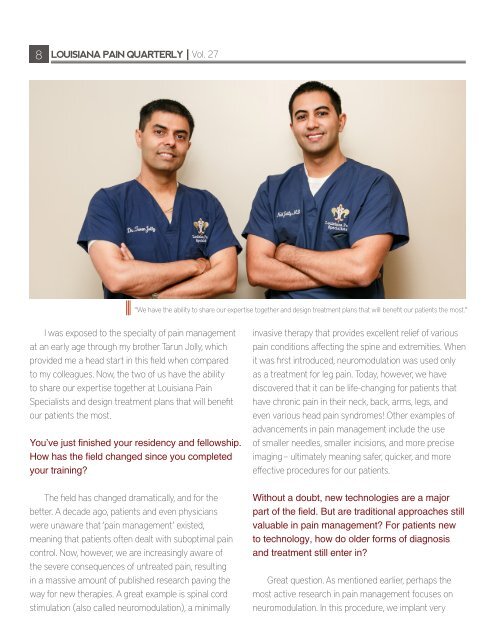LOUISIANA PAIN
LPQ-Summer-2016
LPQ-Summer-2016
Create successful ePaper yourself
Turn your PDF publications into a flip-book with our unique Google optimized e-Paper software.
8<br />
<strong>LOUISIANA</strong> <strong>PAIN</strong> QUARTERLY<br />
Vol. 27<br />
“We have the ability to share our expertise together and design treatment plans that will benefit our patients the most.”<br />
I was exposed to the specialty of pain management<br />
at an early age through my brother Tarun Jolly, which<br />
provided me a head start in this field when compared<br />
to my colleagues. Now, the two of us have the ability<br />
to share our expertise together at Louisiana Pain<br />
Specialists and design treatment plans that will benefit<br />
our patients the most.<br />
You’ve just finished your residency and fellowship.<br />
How has the field changed since you completed<br />
your training?<br />
The field has changed dramatically, and for the<br />
better. A decade ago, patients and even physicians<br />
were unaware that ‘pain management’ existed,<br />
meaning that patients often dealt with suboptimal pain<br />
control. Now, however, we are increasingly aware of<br />
the severe consequences of untreated pain, resulting<br />
in a massive amount of published research paving the<br />
way for new therapies. A great example is spinal cord<br />
stimulation (also called neuromodulation), a minimally<br />
invasive therapy that provides excellent relief of various<br />
pain conditions affecting the spine and extremities. When<br />
it was first introduced, neuromodulation was used only<br />
as a treatment for leg pain. Today, however, we have<br />
discovered that it can be life-changing for patients that<br />
have chronic pain in their neck, back, arms, legs, and<br />
even various head pain syndromes! Other examples of<br />
advancements in pain management include the use<br />
of smaller needles, smaller incisions, and more precise<br />
imaging – ultimately meaning safer, quicker, and more<br />
effective procedures for our patients.<br />
Without a doubt, new technologies are a major<br />
part of the field. But are traditional approaches still<br />
valuable in pain management? For patients new<br />
to technology, how do older forms of diagnosis<br />
and treatment still enter in?<br />
Great question. As mentioned earlier, perhaps the<br />
most active research in pain management focuses on<br />
neuromodulation. In this procedure, we implant very


